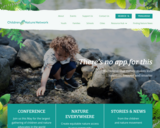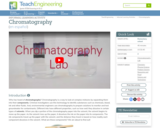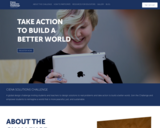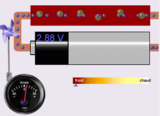
Series of videos on the Chemistry created by the team at Crash Course
- Subject:
- Chemistry
- Science
- Material Type:
- Lesson
- Provider:
- Crashcourse
- Date Added:
- 05/21/2018

Series of videos on the Chemistry created by the team at Crash Course

Nature has the power to make children healthier, happier and smarter. But over the last few generations, childhood has moved indoors, leaving kids disconnected from the natural world. This worldwide trend has profound implications for children’s healthy development—and the future of our planet.

This site offers a fun guide to gardening for kids.

Hank introduces us to ourselves by taking us on a journey through the fascinatingly diverse phyla known as chordata. And the next time someone asks you who you are, you can give them the facts: you're a mammalian amniotic tetrapodal sarcopterygian osteichthyen gnathostomal vertebrate cranial chordate.

Christmas is a time for sharing, singing, decorating, and enjoying the season. Experience the joy with your students, using these Christmas lesson plans, activities, printables, and skill builders. There are free worksheets, bulletin board ideas, printable art activities, literature units, and more! They will also enjoy Christmas games that you will find educational as well. You can discuss the religious and cultural meaning behind Christmas in your social studies class, create holiday crafts and decorations for art class, incorporate the seasonal theme into your math class, and read Christmas books in reading class. There is so much for your students to enjoy!

To increase students' awareness of possible invisible pollutants in drinking water sources, students perform an exciting lab requiring them to think about how solutions and mixtures exist even in unsuspecting places such as ink. They use alcohol and chromatography paper to separate the components of black and colored marker ink. Students witness first-hand how components of a solution can be separated, even when those individual components are not visible in solution.

Students use chromatography to separate the components of ink.

What is Chrome Music Lab?
Chrome Music Lab is a website that makes learning music more accessible through fun, hands-on experiments.
What can it be used for?
Many teachers have been using Chrome Music Lab as a tool in their classrooms to explore music and its connections to science, math, art, and more. They’ve been combining it with dance and live instruments. Here’s a collection of some uses we’ve found on Twitter.

Be a change maker; design solutions.
The next generation of problem-solvers need more than technical skills and expertise. They need experiences that allow them to see the designed world and its impact on people, collaborate and empathize across differences, and leverage their skills to redesign the world around them to meet the needs of all people in their communities.

Radio, Cinema, and Television have been staples in news coverage, entertainment, and education for almost 100 years. But... where did they all come from? Who started what and when and why? In this episode, Hank Green talks to us about their birth and a dead elephant.

Une série de simulations provenant de l’Université de Colorado à Boulder pour les 9e – 12e au sujet des sciences. Cette simulation démontre le processus de circuit batterie-résistance.
Regardez à l'intérieur d'une résistance pour comprendre son fonctionnement. Augmentez la tension de la batterie pour faire passer davantage d'électrons à travers la résistance. Augmentez la résistance pour bloquer le flux d'électrons. Observez le changement de courant et la température de la résistance.

Students are introduced to several key concepts of electronic circuits. They learn about some of the physics behind circuits, the key components in a circuit and their pervasiveness in our homes and everyday lives. Students learn about Ohm's Law and how it is used to analyze circuits.

Students use the same method as in the activity from lesson 2 of this unit to explore the magnetism due to electric current instead of a permanent magnet. Students use a compass and circuit to trace the magnetic field lines induced by the electric current moving through the wire. Students develop an understanding of the effect of the electrical current on the compass needle through the induced magnetic field and understand the complexity of a three dimensional field system.

Hank takes us on a trip around the body - we follow the circulatory and respiratory systems as they deliver oxygen and remove carbon dioxide from cells, and help make it possible for our bodies to function.

Students learn that ordinary citizens, including students like themselves, can make meaningful contributions to science through the concept of "citizen science." First, students learn some examples of ongoing citizen science projects that are common around the world, such as medical research, medication testing and donating idle computer time to perform scientific calculations. Then they explore Zooniverse, an interactive website that shows how research in areas from marine biology to astronomy leverage the power of the Internet to use the assistance of non-scientists to classify large amounts of data that is unclassifiable by machines for various reasons. To conclude, student groups act as engineering teams to brainstorm projects ideas for their own town that could benefit from community help, then design conceptual interactive websites that could organize and support the projects.

We’re beginning our engineering journey with a tour through the major branches. Today Shini explains the facets of civil engineering, including structural and construction engineering, city planning, transportation, and sanitation.

In this activity, students construct classic slide rules and use them like calculators. Students use the slide rules to read scales, determine significant figures, and estimate decimal places.åÊ This is activity D3 in the "Far Out Math" educator's guide. Lessons in the guide include activities in which students measure, compare quantities as orders of magnitude, become familiar with scientific notation, and develop an understanding of exponents and logarithms using examples from NASA's GLAST mission. These are skills needed to understand the very large and very small quantities characteristic of astronomical observations. Note: In 2008, GLAST was renamed Fermi, for the physicist Enrico Fermi.

Find over 1 million free activities, simulations, exercises, lessons, and games for math & science!
Resources are organized by: Elementary, Middle School, High School & College.

Students use bearing measurements to triangulate and determine objects' locations. Working in teams of two or three, they must put on their investigative hats as they take bearing measurements to specified landmarks in their classroom (or other rooms in the school) from a "mystery location." With the extension activity, students are challenged with creating their own maps of the classroom or other school location and comparing them with their classmates' efforts.

Students learn about gear ratios and power by operating toy mechanical cranes of differing gear ratios. They attempt to pick up objects with various masses to witness how much power must be applied to the system to oppose the force of gravity. They learn about the concept of gear ratio and practice calculating gear ratios on worksheets, discovering that smaller gear ratios are best for picking objects up quickly, and larger gear ratios make it easier to lift heavy objects.